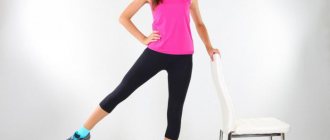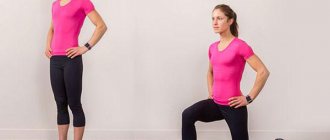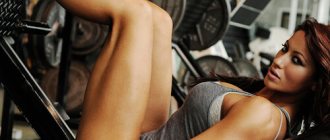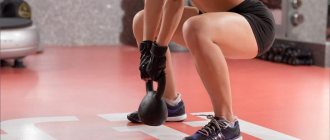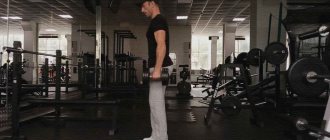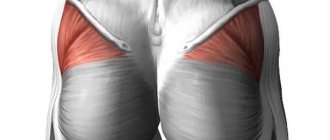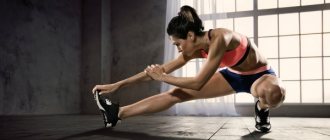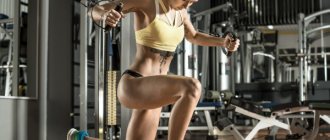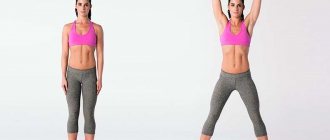The absence of excess weight does not always guarantee a slim and fit body. If you are not satisfied with your own silhouette, then yoga exercises for the legs and buttocks will help improve your position. Dissatisfaction with your figure can be caused by the presence of subcutaneous fat, which accumulates in “problem” areas. It makes the skin more flabby and provokes loss of muscle tone. The formation of subcutaneous fat can be caused by a lack of physical activity and a sedentary lifestyle.
You can cope with the problem even at home. If you correctly create a yoga exercise program and follow a certain diet, you will be able to tone the muscles in the desired areas.
Why yoga? Properly chosen exercises guarantee not only achieving the intended goal, but also increasing skin elasticity, excellent stretching, strengthening muscles, and normalizing metabolic processes. Yoga allows you to achieve perfect stretching, strengthens the musculoskeletal and ligamentous systems, gives good spirits and a great mood for the whole day.
How is yoga different from fitness?
Today, yoga classes are offered in many fitness centers. It is important to understand that there is a huge difference between fitness and mastering asanas. Fitness is primarily about working the muscles, while yoga classes have an element of meditation: the atmosphere in the room, dim lighting, and breathing exercises set you up to achieve harmony.
Yoga classes are designed so that participants achieve peace of mind, and not just exercise the body. In yoga, one learns to properly communicate with one’s own body, which becomes a tool for achieving a harmonious state. The loads in yoga are often less than in standard fitness (strength, cardio, interval training), but they are still sufficient to improve health.
Vajrasana and Virasana for lightness in the legs
Vajrasana and Virasana are the most important sitting poses that most of us underestimate.
“Often people find it difficult to squat and sit on the floor because everyone sits on chairs these days. If your knees or ankles, hips or spine are starting to give you trouble, it’s time to learn to sit on the floor.”
Vajrasana and Virasana form the correct arch of the feet and are useful for flat feet. If you have been standing on your feet a lot, walking and your legs are tired, the best way to relieve fatigue and tension is to do Vajrasana and Virasana. If you get nervous, do Vajrasana and Virasana - the nervous tension will subside (the feet, legs, and calf muscles accumulate nervous tension, and these poses relieve them).
If you have problems in your knees, then you need to contact an experienced teacher to learn these poses, which can improve the condition of your knees if performed correctly, and worsen if performed incorrectly.
Vajrasana - lightning strike pose. Unlike Virasana, in it both the knees and feet are together, the weight falls more on the outer parts of the knees and feet and their inner parts open.
- Tie your ankles together with a strap so that your heels are pressed together.
- Place your knees bent on the floor, bringing them together, your shins and the back of your feet, with your toes pointing back. Place the blanket deep into your knees so that it completely covers your legs and feet and sit on your heels.
- Place your palms on your thighs. The blanket will be between your thighs and shins. The blanket is needed so that there is more space inside the knees, this relieves tension from the knees. Sit upright, do not lean forward or backward, right or left. Stretch your toes back, push your shins off the floor. Release your buttocks down and draw them in so that your lower back does not fall forward. Point your tailbone inward and lengthen your spine from your tailbone to the top of your head and toward the ceiling. Press your palms to your thighs, move your shoulders and elbows back, and retract your shoulder blades. Look straight ahead. Relax your face and eyes. Breathe calmly and evenly. Stay in the pose for 2-5 minutes.
- If it hurts you to sit, your feet and ankles hurt, then place several blankets under your knees, shins and the middle of your feet so that your toes are on the floor and your ankles, shins and knees are on these blankets, as in the photo of Virasana. Do the pose like this for some time (about 1 month), and then without blankets.
Virasana is a seated warrior pose. Unlike Vajrasana, the weight in it falls more on the inner parts of the knees and feet, so their outer parts open more.
Bend your legs and kneel on the floor. Bring your knees together, spread your shins and feet apart by hip width, point your toes back, and sit between your feet.
To relieve tension in your knees, place a rope, belt, or folded blanket in your knees to create more space in your knees and relieve tension. If you cannot sit on the floor, place a brick or a folded blanket under the basin. Place your palms on your thighs.
Sit upright, do not lean forward or backward, right or left. Stretch your toes back, push your shins off the floor. Release your buttocks down and draw them in so that your lower back does not fall forward. Point your tailbone inward and lengthen your spine from your tailbone to the top of your head and toward the ceiling. Press your palms to your thighs, move your shoulders and elbows back, and retract your shoulder blades. Look straight ahead. Relax your face and eyes. Breathe calmly and evenly. Stay in the pose for 2-5 minutes.
If it hurts you to sit, your feet and ankles hurt, then place several blankets under your knees, shins and middle of your feet so that your toes are on the floor and your ankles, shins and knees are on these blankets. Do the pose like this for some time (about 1 month), and then without blankets.
To successfully learn Virasana, we offer several variations of this pose. These variations are very good after a long walk, when your legs are very tired; girls and ladies after walking in heels. A few minutes of practice will quickly relieve fatigue and give freshness and vigor to your legs and whole body.
Exercises for hips and buttocks
Yoga for hips and buttocks is a set of asanas that help work out problem areas. The complex must be repeated daily or every other day, especially if you are a beginner. This will allow you to achieve optimal results in a fairly short period of time. Exercises help prevent the accumulation of fat deposits, achieve mental balance and better physical shape. It is enough to devote 30 minutes of free time a day to exercise.
Flow yoga instructor Alexandra Shumkova demonstrates how to perform the exercises correctly.
Utkatasana
This asana involves engaging the muscles of the lower limbs. The maximum load falls on the hips and buttocks. To get into the correct starting position, imitate sitting on a chair. In fact, there shouldn’t be a chair under you, so we use our imagination. Since there is no support under the body, the body begins to actively engage the muscle groups of the hips and pelvis. The asana helps improve muscle tone, strengthening and training.
The starting position is called Tadasana. Smoothly bending your knees, you need to gradually lower your pelvis. You perform the movement as if you were sitting on a chair or armchair. As you inhale, you need to extend your arms above your head. It is enough to maintain this position for two or three respiratory acts. It is important to control proper breathing. A few seconds after starting the exercise, you should straighten up, returning to your starting standing position.
Note! Always listen to how your body responds to a particular exercise. Try to go as low as possible and gradually increase the depth. If the pose is easy enough for you, try standing on your toes. This will make stretching muscle fibers more effective.
Virabhadrasana II
Yoga for the hips helps to effectively work out the legs. In this case, the maximum load will be applied to the inner thigh. This feature can confidently be called the main advantage of the asana. At first glance, the exercise may seem quite simple, but it is not. It helps to work those muscles that we practically do not use in everyday life.
To begin performing the asana, you should spread your legs wider than your hips.
The right leg should be turned outward. The left leg also actively works to maintain balance. The legs should be placed so that the center of the left foot is in line with the right. By straightening your arms to the sides, you expand your chest. The pelvis should be lowered. The arms should form a single line with the shoulders and be directed forward. The occupied position must be constantly monitored to prevent deviations from it. Breathing should be strong enough, but slow. After completing the exercise, you should relax and then repeat it on the other side.
Note! To achieve the best results, you need to constantly work on stretching. The pose should be balanced and collected. The pelvis should be lowered as low as possible.
Ushtrasana
This asana provides effective opening of the chest as well as the hip flexors. By regularly repeating the pose, you will be able to keep your entire body in good shape. This exercise is aimed primarily at stimulating and stretching the muscle fibers of the thighs.
To begin performing, you need to take Vajrasana. The torso and hip part must be positioned so that the calf and thighs form a right angle with each other. By bending forward, you help yourself open your chest. As you stretch your arms, try to touch your feet with your palms. The head must be tilted back (if you have strong neck muscles and there are no problems in the cervical spine), and the movements should be smooth and careful. While holding the pose, you should relax and breathe deeply.
Upavistha Konasana
To keep your upper legs toned, you need to perform this asana regularly. It also helps improve stretching by engaging the inner thigh muscles. When performing most exercises, minimal attention is paid to them.
To begin the exercise, you should sit in Dandasana. Legs in a sitting position should be spread as wide as possible. If you can’t achieve your goal right away, trainers advise spreading your legs gradually. This must be done carefully, taking care of joints and ligaments. Your arms must be extended so that they are between your legs - in front. If you have good flexibility, try to gently bend your body and touch the floor with your head. If this fails, just relax your neck and bend your elbows, leaving your head hanging. After taking a few breaths, you can gradually return to the starting position.
Janu Sirsasana
This asana is focused on developing flexibility in the articulation of the hips and pelvis. The pose provides excellent stretching of muscle tissue and helps activate blood circulation in the tissues. By doing exercises regularly, you can keep your pelvic muscles toned and get in good physical shape.
To perform the asana, you need to take Dandasana. The left knee should be bent so that the foot is pressed against the inner thigh of the right leg. The arms should be extended upward and the body should be bent. It is necessary to place your stomach on your thigh and reach with your hands towards your right foot, while making sure that your back is as straight as possible. If you lack preparation, you can slightly bend your leg at the knee. The air should be inhaled with the stomach. Having frozen in this position for a few seconds, you can return to the original position and change sides.
Note! To perform the asana, you need to touch your head to the knee joint. It is quite difficult to do this without physical training, so you should do everything gradually. Stretch as far as you can.
Sports Fitness Yoga: Exercises for the abs, hips and more
Text: Karina Sembe
Yesterday we talked about how yoga became a fitness trend and what its health benefits are. Yoga can do a lot - from toning muscles and increasing the elasticity of ligaments to relieving stress and combating insomnia. The combination of static and dynamic loads while performing a sequence of asanas allows you to effectively burn calories and tighten your figure. We strongly recommend that you do not start getting acquainted with yoga without the help of a qualified trainer: who, if not him, will determine your optimal level of load, show the principle of performing the exercises and control the technique? In addition, regular long-term training in the studio will definitely provide a tangible effect.
When you realize that you are ready to go free swimming, you can start training at home. Classic yoga training is characterized by its integrity: in the standard Ashtanga Vinyasa complex, all muscle groups are involved. However, yoga and fitness trainers often offer yoga-based training systems, where the emphasis is on individual muscle groups.
We have selected effective and technical sets of such exercises of varying durations, which can be performed as independent stretching or as a so-called cool-down after training for the purpose of general relaxation or to pump up muscles. Note that the sequence of positions in yoga is not without logic: asanas are often interconnected, and each subsequent load is aimed at compensating for the previous one. Well-designed yoga-inspired workouts tend to take this principle into account.
Body and press
In yoga, the core is worked out with a bang: in constant twists, bends and deflections, you use muscles that you didn’t even suspect you had before, and regularly performing all sorts of variations of the seemingly elementary “boat” pose will pump up your abs no worse than endless body lifts.
Back
Performing a number of yogic poses and ligaments has a beneficial effect on the development of the muscular corset and is useful for normalizing the functioning of the spine. In some cases (for example, with slipped discs and certain types of protrusions), incorrect loading can aggravate the disease, so if you have ever been bothered by pain or discomfort in your back, consult your doctor before starting exercise and practice with extreme caution.
Hands
Emphasis on the hands occurs in almost every second exercise from any standard hatha yoga complex. For those who don’t have time for hour-long workouts, we offer short series of exercises for toned and strong arms.
Hips and legs
Strengthen the muscles of the thighs and buttocks, tighten the calves, relieve fatigue in the legs, stretch after a run or strength training - all this can be done with the help of simple exercises based on yoga.
Intense full body workout
There is an opinion that yoga is always very slow and very sedentary. The opinion is wrong: Ashtanga Vinyasa yoga training with dynamic ligaments and yoga-based fitness are not inferior in intensity to hard cardio and can burn no less calories than functional training.
Photos: cover photo via Shutterstock
